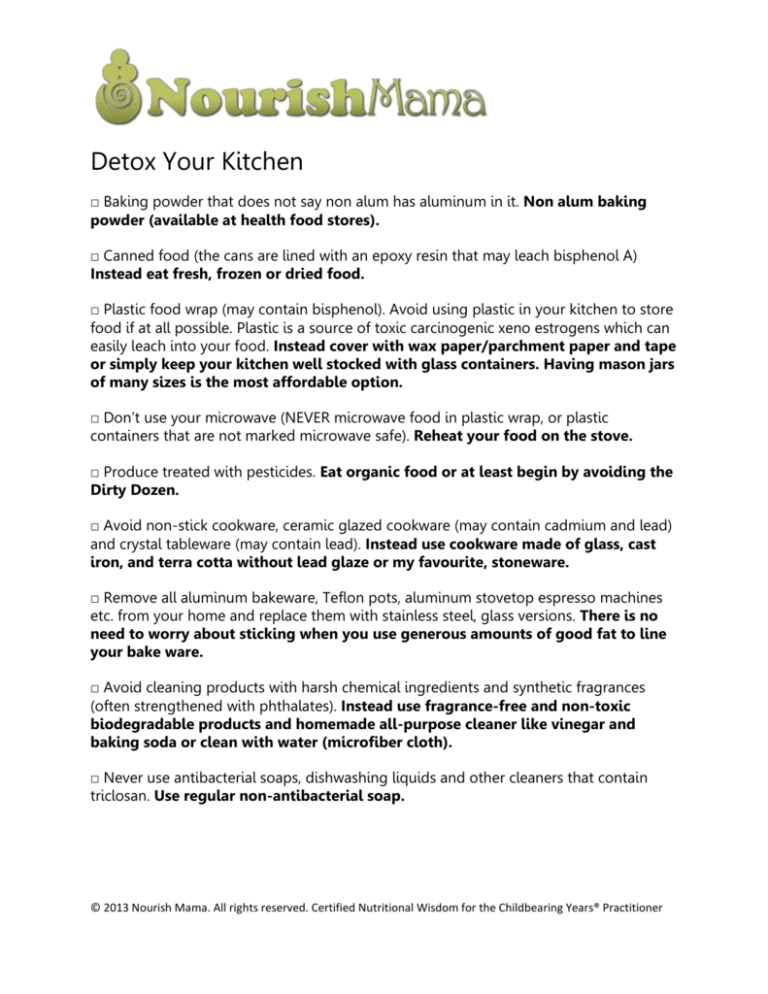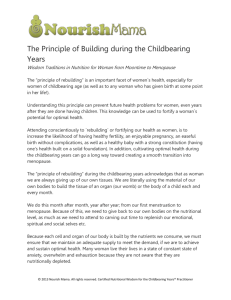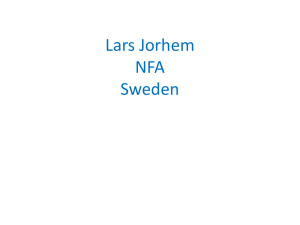
Detox Your Kitchen
□ Baking powder that does not say non alum has aluminum in it. Non alum baking
powder (available at health food stores).
□ Canned food (the cans are lined with an epoxy resin that may leach bisphenol A)
Instead eat fresh, frozen or dried food.
□ Plastic food wrap (may contain bisphenol). Avoid using plastic in your kitchen to store
food if at all possible. Plastic is a source of toxic carcinogenic xeno estrogens which can
easily leach into your food. Instead cover with wax paper/parchment paper and tape
or simply keep your kitchen well stocked with glass containers. Having mason jars
of many sizes is the most affordable option.
□ Don’t use your microwave (NEVER microwave food in plastic wrap, or plastic
containers that are not marked microwave safe). Reheat your food on the stove.
□ Produce treated with pesticides. Eat organic food or at least begin by avoiding the
Dirty Dozen.
□ Avoid non-stick cookware, ceramic glazed cookware (may contain cadmium and lead)
and crystal tableware (may contain lead). Instead use cookware made of glass, cast
iron, and terra cotta without lead glaze or my favourite, stoneware.
□ Remove all aluminum bakeware, Teflon pots, aluminum stovetop espresso machines
etc. from your home and replace them with stainless steel, glass versions. There is no
need to worry about sticking when you use generous amounts of good fat to line
your bake ware.
□ Avoid cleaning products with harsh chemical ingredients and synthetic fragrances
(often strengthened with phthalates). Instead use fragrance-free and non-toxic
biodegradable products and homemade all-purpose cleaner like vinegar and
baking soda or clean with water (microfiber cloth).
□ Never use antibacterial soaps, dishwashing liquids and other cleaners that contain
triclosan. Use regular non-antibacterial soap.
© 2013 Nourish Mama. All rights reserved. Certified Nutritional Wisdom for the Childbearing Years® Practitioner
The Dangers of Microwaving Food
Microwaving is not a natural way to cook food.
When we tamper with the natural order of things, there is likely to be a consequence,
whether it be immediate or later down the road (such as the accumulative effects of low
dose radiation exposure).
In the case of microwave ovens, the risks far outweigh the benefits when it comes to
protecting your family’s health.
Here is what the FDA has to say.... “Exposure to high levels of microwaves can cause a
painful burn. The lens of the eye is particularly sensitive to intense heat, and exposure to
high levels of microwaves can cause cataracts. Likewise, the testes are very sensitive to
changes in temperature. Accidental exposure to high levels of microwave energy can
alter or kill sperm, producing temporary sterility. But these types of injuries - burns,
cataracts, temporary sterility - can only be caused by exposure to large amounts of
microwave radiation, much more than the 5mW limit for microwave oven leakage. Less
is known about what happens to people exposed to low levels of microwaves.
Controlled, long-term studies involving large numbers of people have not been
conducted to assess the impact of low level microwave energy on humans. Much
research has been done with experimental animals, but it is difficult to translate the
effects of microwaves on animals to possible effects on humans. For one thing, there are
differences in the way animals and humans absorb microwaves. For another,
experimental conditions can't exactly simulate the conditions under which people use
microwave ovens. However, these studies do help us better understand the possible
effects of radiation.... The fact that many scientific questions about exposure to lowlevels of microwaves are not yet answered requires FDA to continue to enforcement of
radiation protection requirements. Consumers should take certain common sense
precautions......(such as) don't stand directly against an oven (and don't allow children to
do this) for long periods of time while it is operating.”
In other words, they are not sure if microwave technology is safe for you or your family.
So why be part of the experiment of this unproven to be safe technology then?
Especially when a simple toaster oven can replace the use of the microwave oven for
reheating leftovers, and liquids can be easily reheated in a pot on the stove (the extra
© 2013 Nourish Mama. All rights reserved. Certified Nutritional Wisdom for the Childbearing Years® Practitioner
step needed to clean the pot is negligible in terms of the benefit of avoiding being part
of the great microwave experiment).
Here is the short list of the potential ill effects that microwave radiation has on your
food:
Destroys and reduces the nutrients in your food that are necessary to sustain life.
Alters the chemical structure of food thereby producing toxins
Produces carcinogenic compounds that have been shown to lead to cancer
The research, from Pediatrics (vol. 89, no. 4, April 1992) on microwaving human breast
milk showed:
Cuts down on lysozyme activity
Reduces key antibodies
Promotes potentially dangerous bacteria.
Milk heated to 72 degrees lost a full 96% of all immunoglobulin-A antibodies, which
fight invading microbes.
Ten Reasons not to Use Your Microwave Oven Based on Swiss, Russian and
German clinical studies
1. Continually eating food processed from a microwave oven causes long term,
permanent, brain damage by "shorting out" electrical impulses in the brain [depolarizing or de-magnetizing the brain tissue].
2. The human body cannot metabolize [break down] the unknown by-products
created in micro-waved food.
3. Male and female hormone production is shut down and/or altered by continually
eating micro-waved foods.
4. The effects of micro-waved food by-products are residual [long term, permanent]
within the human body.
5. Minerals, vitamins, and nutrients of all micro-waved food is reduced or altered so
that the human body gets little or no benefit, or the human body absorbs altered
compounds that cannot be broken down.
6. The minerals in vegetables are altered into cancerous free radicals when cooked
in a microwave oven.
© 2013 Nourish Mama. All rights reserved. Certified Nutritional Wisdom for the Childbearing Years® Practitioner
7. Micro-waved foods cause stomach and intestinal cancerous growths [tumors].
This has been a primary contributor to the rapidly increased rate of colon cancer
in the United States.
8. The prolonged eating of micro-waved foods causes cancerous cells to increase in
human blood.
9. Continual ingestion of micro-waved food causes immune system deficiencies
through lymph gland and blood serum alterations.
10. Eating micro-waved food causes loss of memory, concentration, emotional
instability, and a decrease of intelligence.
References and Resources:
Resources for Your Radiation Emitting Products
http://www.fda.gov/RadiationEmittingProducts/ResourcesforYouRadiationEmittingProducts/ucm252762.htm
Are Microwaves Ovens Dangerous?
http://www.safespaceprotection.com/electrostress-from-microwave-ovens.aspx
The Hidden Hazards of Microwave Cooking
http://www.health-science.com/microwave_hazards.html
The Proven Dangers of Microwaves
http://www.mercola.com/article/microwave/hazards2.htm
How and Why Microwave Cooking Causes Cancer
http://www.naturalnews.com/030651_microwave_cooking_cancer.html
Why Did the Russians Ban An Appliance Found in 90% of American Homes?
http://articles.mercola.com/sites/articles/archive/2010/05/18/microwave-hazards.aspx
Do you Microwave Your Food? You’re Zapping Away Nutrients and Risking Your Health
http://articles.mercola.com/sites/articles/archive/2003/11/05/microwave-food.aspx
© 2013 Nourish Mama. All rights reserved. Certified Nutritional Wisdom for the Childbearing Years® Practitioner
'Dirty Dozen' Cosmetic Chemicals To Avoid
(excerpted from http://www.davidsuzuki.org/issues/health/science/toxics/dirtydozencosmetic-chemicals/)
1. BHA and BHT
Used mainly in moisturizers and makeup as preservatives. Suspected endocrine
disruptors and may cause cancer (BHA). Harmful to fish and other wildlife.
2. Coal tar dyes: p-phenylenediamine and colours listed as "CI" followed by a five
digit number
In addition to coal tar dyes, natural and inorganic pigments used in cosmetics are also
assigned Colour Index numbers (in the 75000 and 77000 series, respectively).
Look for p-phenylenediamine hair dyes and in other products colours listed as "CI"
followed by five digits.1 The U.S. colour name may also be listed (e.g. "FD&C Blue No. 1"
or "Blue 1"). Potential to cause cancer and may be contaminated with heavy metals toxic
to the brain.
3. DEA-related ingredients
Used in creamy and foaming products, such as moisturizers and shampoos. Can react to
form nitrosamines, which may cause cancer. Harmful to fish and other wildlife. Look also
for related chemicals MEA and TEA.
4. Dibutyl phthalate
Used as a plasticizer in some nail care products. Suspected endocrine disrupter and
reproductive toxicant. Harmful to fish and other wildlife.
5. Formaldehyde-releasing preservatives
Look for DMDM hydantoin, diazolidinyl urea, imidazolidinyl urea, methenamine and
quarternium-15. Used in a variety of cosmetics. Slowly release small amounts of
formaldehyde, which causes cancer.
6. Parabens
Used in a variety of cosmetics as preservatives. Suspected endocrine disrupters and may
interfere with male reproductive functions.
7. Parfum (a.k.a. fragrance)
Any mixture of fragrance ingredients used in a variety of cosmetics — even in some
products marketed as "unscented." Some fragrance ingredients can trigger allergies and
asthma. Some linked to cancer and neurotoxicity. Some harmful to fish and other
wildlife.
© 2013 Nourish Mama. All rights reserved. Certified Nutritional Wisdom for the Childbearing Years® Practitioner
8. PEG compounds
Used in many cosmetic cream bases. Can be contaminated with 1.4-dioxane, which may
cause cancer. Also for related chemicals, propylene glycol and other ingredients with
the letters "eth" (e.g., polyethylene glycol).
9. Petrolatum
Used in some hair products for shine and as a moisture barrier in some lip balms, lip
sticks and moisturizers. A petroleum product that can be contaminated with polycyclic
aromatic hydrocarbons, which may cause cancer.
10. Siloxanes
Look for ingredients ending in "-siloxane" or "-methicone." Used in a variety of
cosmetics to soften, smooth and moisten. Suspected endocrine disrupter and
reproductive toxicant (cyclotetrasiloxane). Harmful to fish and other wildlife.
11. Sodium laureth sulfate
Used in foaming cosmetics, such as shampoos, cleansers and bubble bath. Can be
contaminated with 1,4-dioxane, which may cause cancer. Look also for related chemical
sodium lauryl sulfate and other ingredients with the letters "eth" (e.g., sodium laureth
sulfate). http://www.davidsuzuki.org/issues/health/science/toxics/chemicals-in-yourcosmetics---sodium-laureth-sulfate/index.php
12. Triclosan
Used in antibacterial cosmetics, such as toothpastes, cleansers and antiperspirants.
Suspected endocrine disrupter and may contribute to antibiotic resistance in bacteria.
Harmful to fish and other wildlife.
© 2013 Nourish Mama. All rights reserved. Certified Nutritional Wisdom for the Childbearing Years® Practitioner
Detoxing Your Bathroom
□ Cosmetics, toiletries and perfumes with synthetic fragrances (many contain phthalates
and other harmful chemicals). Human skin absorbs most things from the environment
very efficiently, in some cases better than our digestive system. Reduce general toxic
load by looking at all of the cleaning supplies, cosmetics and personal care products
that are in your home and replace them with non-toxic natural products.
You can find out just how toxic your products are and which ones are the least toxic @
www.cosmeticsdatabase.com (avoid soap, shower gels and bubble baths whenever
possible). Miessence Brand cosmetics is the best because it is Certified Organic to
organic FOOD standards, not organic COSMETIC standards (which are lower).
□ Deodorant and antiperspirant (contain aluminum and other nasty chemicals). Use
deodorant stone, homemade version made with coconut oil & baking soda or
Miessence roll on.
□ Perfume (petroleum based). Essential oils.
□ Anti-bacterial toothpaste, toothbrushes and mouthwashes that contain triclosan Nonantibacterial products. Miessence Brand.
□ Sanitary products bleached with chlorine, or made of pesticide-treated cotton. Use
organic cotton and unbleached disposable sanitary products or better yet cloth
pads, the Diva cup or sea sponges.
□ Vinyl shower curtains, and fabric shower curtains with a water-repellent coating.
Hemp shower curtains.
□ Chlorine and Fluoride: Avoid bathing, showering or drinking chlorinated or fluoridated
water, all of which kills your beneficial microflora. Avoid swimming in pools and instead
swim in natural non polluted living waters which are full of life, biological energy
from plants and other life forms, minerals, enzymes and many other beneficial
substances. Chlorine is a poison, which affects every system in the body, particularly the
immune system and the liver. It absorbs very well through the skin (some sources say as
much as 10 times better absorption than drinking it!). In addition, a thick layer of
chlorine gas floats above the swimming pool and is inhaled unknowingly by swimmers.
Ozonated or natural pools are best, since even salt water pools use chlorine. Use
water and shower filters.
© 2013 Nourish Mama. All rights reserved. Certified Nutritional Wisdom for the Childbearing Years® Practitioner
Detoxing Your Laundry
□ Laundry detergents and fabric softeners with synthetic fragrances. Fragrance-free,
biodegradable detergent, soapnuts or other natural homemade washing
detergent.
□ Chlorine bleach Food Grade H2O2
□ Dry clean only clothes (most dry cleaners use PERC). Purchase machine washable
clothes.
□ Clothing with stain repellents, wrinkle resistant treatments (they contain
formaldehyde), brominated flame retardants or pesticide-treated cottons. Organic,
unbleached clothing made of cotton, hemp, linen or wool.
© 2013 Nourish Mama. All rights reserved. Certified Nutritional Wisdom for the Childbearing Years® Practitioner
Simple and Affordable Ways to Improve Your Indoor
Air Quality
1) Houseplants: geraniums, ivies, spider plants, aloe vera, focuses, bamboo palm, rubber
plant, English ivy, dwarf date palm, boston fern, peace lily, corn plant “massangeana”,
Kimberly queen, florist’s mom, gerbera daisy (3 plants per 100 square feet in a home or
office will improve air quality (based on research that measured how well a single plant
works to clean the air in a sealed chamber of common pollutants such as ammonia,
formaldehyde and benzene by Dr. Wolverton in his book “How to Grow Fresh Air”)
The square footage of my home is:____________________ Divided by 100=_____________ x
3=______________ is how many plants needed to detoxify the air in my home.
2) If you use incense, make sure it is natural (not perfume) eg: www.JuniperRidge.com
3) Himalayan Rock Salt Lamps
4) Beeswax Candles
5) Keep your house free of dust and mould (to keep plants free of mould, put a layer of
aquarium gravel on the surface of the soil)
6) Purchase gently used clothes, toys and furniture to prevent sometimes years of
inhaling off gassing fumes
7) Air out your house regularly and spend a lot of time outdoors in fresh air
8) Air Filtration Systems (not so affordable but worth the investment)
© 2013 Nourish Mama. All rights reserved. Certified Nutritional Wisdom for the Childbearing Years® Practitioner
How to Choose Quality Water
Did you know that we humans are actually 75% water? Drinking clean fresh mineral rich
water is a great way to bathe the insides of our body. Not only does proper hydration
give us dewy clear skin, but it is very energizing as well.
To get a visual of the way hydration can perk us up, think back to a time when you may
have neglected to water a plant and how quickly it changes from withered to vibrant in
no time with proper hydration!
The best kind of water is natural mineral rich water that is bottled at the source from a
spring.
Be aware though that bottled water may be a source of xenoestrogens (man made
estrogen like substances that cause hormonal imbalance in men, women and children).
Avoid distilled & reverse osmosis (because they don’t contain any naturally occurring
minerals- when water has no minerals, it will leach the minerals from your bones).
It is best to use filtered tap water (something that removes chlorine, fluoride,
pathogenic bacteria, cysts and parasites entirely and extracts harmful chemicals such as
herbicides, pesticides, VOCs, organic solvents, radon 22, trihalomethanes, nitrates,
nitrites and unhealthy minerals such as lead and mercury - without removing the
beneficial minerals your body needs).
Here is an affordable countertop filter that eliminates chlorine and fluoride:
http://www.gtawater.com/assets/water-filter-fluoride-removal-toronto-canada.htm
Another option is Berkey`` brand if you want a stand alone filtration system:
http://www.berkeywaterfiltercanada.com/Royal-Berkey-_p_26.html
© 2013 Nourish Mama. All rights reserved. Certified Nutritional Wisdom for the Childbearing Years® Practitioner
Xenoestrogens
The human body makes three different estrogen hormones - estrase, estrone and
estriol.
Plants also produce estrogen-like compounds called phytoestrogens. These compounds
are not chemically identical to the estrogens produced by the body, but they still attach
to estrogen receptor sites and can influence reproductive health.
Xenoestrogens are environmental pollutants that have estrogen-like activity. These
compounds are a primary cause of reproductive health problems in both women and
men because they attach to and over-stimulate estrogen receptor sites. This causes
changes in estrogen-sensitive tissues like the breasts, uterus and prostate.
Xenoestrogens stimulate abnormal changes in these tissues, causing problems like cysts
in the breasts, uterine fibroids, prostate enlargement and cancer.
Sources of xenoestrogens include:
1) phthalates in personal care products (make-up and skin care etc.) plus those in
cleaning products (household cleaners, laundry soap etc.)
2) PCBs in plastic (food storage and water bottles)
3) DDT (although banned in 1972, DDT, like its breakdown product DDE, is a
xenoestrogen which is still present in the environment).
4) Chlorine (showering, bathing, swimming in and drinking chlorinated water).
5) Hormone residues in meats and dairy products as well as pesticides (conventionally
grown and raised food) also have estrogenic effects.
Avoiding all of the above is essential, but even more so if you have symptoms of
estrogens dominance and you are ready to recover from them.
© 2013 Nourish Mama. All rights reserved. Certified Nutritional Wisdom for the Childbearing Years® Practitioner
How To Avoid Estrogens
Avoid all pesticides, herbicides, and fungicides. Wash your food well to rid the pesticides.
Bathe the washed food in a produce wash or ozonated water for 20 minutes before cooking.
Have a good water filter for your source of water.
Use only organic based whole foods when you can. Buy hormone free meats and dairy
products where possible.
Avoid plastic goods - they leach into the environment.
Do not microwave food in plastic containers, and especially avoid the use of plastic wrap to
cover food for microwaving.
Use glass or ceramics whenever possible to store food.
Do not leave plastic containers, especially your drinking water, in the sun.
If a plastic water container has heated up significantly, throw it away - do not drink the
water either.
Don't use fabric softeners as it puts petrochemicals right on your skin.
Use a simple laundry and dish detergent with less chemicals.
Use organic soaps and toothpastes. Avoid fluoride.
Avoid creams and cosmetics that have toxic chemicals and estrogenic ingredients such as
parabens and stearal konium chloride. Switch to more natural products. Cheap brands
usually have more toxic ingredients.
Avoid nail polish and nail polish removers.
Use only naturally based perfumes. Most perfumes are petrochemically based.
Avoid surfactants found in many condoms and diaphragm gels.
Avoid new carpet - it can give off noxious fumes.
Avoid X-rays as much as possible.
© 2013 Nourish Mama. All rights reserved. Certified Nutritional Wisdom for the Childbearing Years® Practitioner
Be aware of noxious gas such as that from copiers and printers, carpets, fiberboards, etc.
Computer monitors can emit a high level of electromagnetic force (EMF). Read about the
Aulterra Neutralizer for preventing EMF damage.
Natural vs. Synthetic Vitamins
Most people are not aware that all vitamins are not created equally, and that 95% of all
vitamins on the market are actually synthetic.
Organic Consumers (www.organicconsumers.org) warns people against synthetic
vitamins particularly; fat-soluble ones as these build up in the fat tissues, fat deposits
and the liver. In addition, they warn that the base of the synthetics can consist of
petrochemical derivatives, nicotine and coal tars (by-products of coal).
How to Upgrade from Synthetic Vitamins to Superfoods
Multivitamin
green smoothies, green superfoods
Vitamin C
amla c, acerola, camu camu
B Vitamins
nutritional yeast, cultured foods & bee
pollen
Probiotics
cultured foods
Iron
liver
Glucosamine/chondroitin
gelatin
Vit A & D
fermented cod liver oil
Enzymes
cultured food
Protein
Vital Whey, hemp
Minerals
Mineral Matrix by St. Francis Herbs
Potassium
Teecino
© 2013 Nourish Mama. All rights reserved. Certified Nutritional Wisdom for the Childbearing Years® Practitioner
Anti inflammatory
evening primrose oil
Essential Oil Scented Epsom Salt Baths
This fast, easy craft is sure to tantalize the senses of both moms and kids! It is the
perfect alternative to bubble bath which is toxic (even the so called natural brands) and
increase susceptibility to vaginal yeast infections.
Read on to learn how and why to make your own both nourishing and detoxifying bath
salts at home.
Why do it:
1) It is a simple, fast, rewarding, sensory and health enriching activity that your kids will
love!
2) It will nourish the whole family (many of us are actually deficient in magnesium, plus
magnesium helps us absorb calcium). Magnesium is also way better absorbed through
the skin, than through digestion.
3) It is a gentle detoxifier that is safe for the whole family.
4) Reduces inflammation and muscle pain.
5) Helps relieve stress by nourishing the adrenals, as well as sedating and toning the
nervous system.
6) It makes bath time luxurious and fun!
7) According to the Epsom Salt Industry Council, it has all the same benefits associated
with magnesium supplementation (improves the body’s ability to use insulin, increases
heart and circulatory health, reduces irregular heartbeats, prevents hardening of the
arteries, reduces blood clots and lowers blood pressure, prevents migraines, improves
mood, concentration and digestion all the while helping you sleep better).
© 2013 Nourish Mama. All rights reserved. Certified Nutritional Wisdom for the Childbearing Years® Practitioner
8) Sulphate triggers the pancreas to release digestive enzymes, helps form proteins in
joints, brain tissue and mucin proteins (the cells that secrete mucous along the digestive
tract).
How to make it:
Step 1: Put 2 cups of magnesium sulphate in a bowl.
Step 2: Add 10-20 drops of your favourite essential oil that is safe for skin application.
Step 3: Mix with a wooden spoon.
Step 4: Put in a half quart canning jar and store in an easily accessible place in the
bathroom.
How to use it:
Dissolve 2 cups epsom salts in a bath (only 1 cup or less for children) that is as hot as
you can tolerate. Soak for a minimum of 12 minutes.
Do this up to 3 times per week to replenish magnesium or to detoxify.
Since magnesium is so well absorbed through the skin, please do not exceed this
amount excess magnesium can be fatal.
Do not let children drink the bathwater as magnesium sulphate is a laxative when taken
internally.
Alternatives:
If you prefer not to use the synthesized form of magnesium, you can use
the magnesium derived from the sea although it is more costly and less accessible.
© 2013 Nourish Mama. All rights reserved. Certified Nutritional Wisdom for the Childbearing Years® Practitioner







